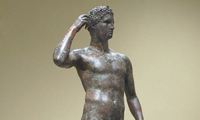 Italian Judge Wants Ancient Statue Seized from Getty Museum
Italian Judge Wants Ancient Statue Seized from Getty MuseumUnknown and Unknown maker, perhaps by a pupil of Lysippos, "Statue of a Victorious Youth 300 - 100 B.C. Bronze with copper inlays. (151.5 x 70 x 27.9 cm) 59 5/8 x 27 9/16 x 11 inches. Accession No. 77.AB.30. The J. Paul Getty Museum, Villa Collection, Malibu, California.
ROME (REUTERS).- An Italian judge ordered the seizure of an ancient Greek statue from the J. Paul Getty Museum on Thursday, the latest round in a lengthy legal dispute over artworks Italy says were looted from its territory.
The Los Angeles-based museum, which bought the bronze statue for $3.9 million in 1977, said it would appeal to Italy's top court against the ruling.
Prosecutors in the Italian city of Pesaro argued that the highly prized sculpture -- which depicts an athlete crowned with an olive wreath -- was illegally smuggled out of Italy and the museum did not carry out proper checks before buying it.
Pesaro judge Lorena Mussoni ordered that the statue, called the "Statue of a Victorious Youth," be "seized from the Getty Museum or wherever it may be at the moment."
In a statement, the J. Paul Getty Trust, one of the richest U.S. art institutions, said it would "vigorously defend its legal ownership of the statue."
It said the same court in Pesaro had dismissed an earlier case in 2007 over whether the statue belonged to Italy, ruling that the statute of limitations had long expired, that there was no one to prosecute under Italian law, and that the Getty was to be considered "a good faith owner."
"In fact, no Italian court has ever found any person guilty of any criminal activity in connection with the export or sale of the statue," the statement said.
"GETTY MUST RETURN STATUE"
Itay has signed a series of agreements with U.S. museums in recent years in a bid to retrieve artworks it says left the country illegally and were improperly purchased by foreign institutions.
It struck a deal with the Getty museum in 2007 for the return of 40 artifacts but agreed to defer further discussions on the statue, which is also known as the "Getty bronze," pending the Italian court ruling.
"This is an historically important decision, that brings to an end the time when our archaeological heritage was ransacked," former culture minister Francesco Rutelli, who signed the 2007 deal with the Getty, said after the Pesaro ruling.
"With today's decision, the Getty museum will have to return this statue of incomparable beauty to Italy," Rutelli said. The almost life-size statue was discovered in 1964 by a fishing trawler from Fano, a small seaside town near Pesaro on the Adriatic coast.
It was originally thought to be the work of Lysippos, a Greek sculptor of the fourth century B.C., though more recent studies date it to the second or third century B.C. It is believed to have been lost at sea after being looted by Romans.
The Getty museum says that it bought the statue through legal channels and with clear title. It also says the art work was netted in international waters. Italy disputes that.
After the statue was found by the Fano fishermen, it was buried in a cabbage patch and later hidden by a priest.
According to Cento Citta', a regional association behind the Pesaro lawsuit, it left Italy in a shipment of medical supplies sent to a missionary in Brasil, before being bought by an internal art consortium in 1971 which later sold it to the Getty museum.
 Italian Judge Wants Ancient Statue Seized from Getty Museum
Italian Judge Wants Ancient Statue Seized from Getty Museum